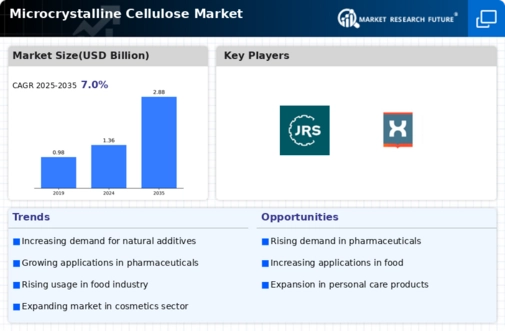Market Trends
Key Emerging Trends in the Microcrystalline Cellulose MCC Market
Medicinal formulations such as tablets, ointments, and other topical treatment bases rely on microcrystalline cellulose for a number of functions, including stabilization, binding, film formation, suspension, and disintegration. Pharmaceutical formulations such tablets, capsules, and sachets rely on it as a binding agent and diluent, solidifying its position as one of the most important excipients in the industry. The demand for pharmaceutical product production is rising and this is precipitating the growth of microcrystalline cellulose market. The demand for microcrystalline cellulose has recently seen an uptick, and the emerging economies like India, Brazil and China are the major contributors to the same.
Along with the elevating trend of global application of processed foods, microcrystalline cellulose market is one other driver. Processed food plays a key role in the market growth, the latest trend of using microcrystalline cellulose as a filler having a positive influence. Given the increasing demand for pharmaceutical products, notably tablets and capsules, microcrystalline cellulose can expect to be seen in frequent demand. The market has not risen as much as it could have due to aspects such as the price fluctuations and the alternative goods being available although such a development in this field is encouraging.
The major players in the microcrystal cellulose arena see the increasing disposable incomes in the developing nations in the Asia-Pacific region as a positive development. Microcrystalline cellulose businesses are highly favored by the current economic trends characterized by increased incomes and appearance of new growth options.
Microcrystalline cellulose has a lot of uses in pharmaceutical sphere, specifically related to product stability and formulation. Development of tablets, ointments, and other therapeutic applications depends on the activity of binder, stabilizer and disintegrants, a very significant role played by each one of them. There are a lot of drugs used in the form of pills capsules and sachets but microcrystalline cellulose which is an excipient is highly used for being good a diluent and for binding. One of the major reasons behind the rapidly increasing number of microcrystalline cellulose being produced is the continuous expansion of pharmaceutical product manufacturing, especially in the developing countries like India, Brazil, and China.
Processed foods that are used in countries around the world create a substantial impact on the microcrystalline cellulose market as well. The market for microcrystalline cellulose keeps growing since, consumption of processed foods raises which, in result, the industry uses the component. The expected increasing demand for pharmaceutical products; namely, tablets and capsules, is also forecasted to escalate the need for microcrystalline cellulose. The market is still in the infancy stage due to the price fluctuations and abundant substitute products although these encouraging trends exist.
On the other hand, the market of microcrystalline cellulose in Asia Pacific looks good owing to the region’s growing GDP and development of middle class. Opportunities for major players in the sector to expand and thrive in this region are being created by the rise in disposable income. Despite hurdles, microcrystalline cellulose is poised to become a major participant in the global market thanks to its numerous applications in medicines and the food industry, as well as rising market potential.


 Source: Secondary Research, Primary Research, Market Research Future Database and Analyst Review
Source: Secondary Research, Primary Research, Market Research Future Database and Analyst Review


Leave a Comment